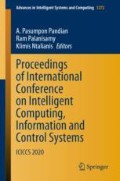Abstract
Global satellite program for remote sensing and earth observation has yielded huge volume of images with rich information. Geoportals such as Bhuvan and USGS host large number of satellite images and tools for analysis. The objective of this paper is to investigate the potential of using freely available satellite images to build a Land Use Land Cover classifier model (LULC) using machine learning approaches. The historically available LULC map is proposed to be used for identifying ground truth labels during classifier construction. Multispectral Landsat-8 images are used as input for classification by decision tree (DT), random forest (RF) and support vector machines (SVM). The data was mapped to six classes according to the International Geosphere-Biosphere Program (IGBP) classification scheme. The performance metrics used for evaluating the classifiers are accuracy, kappa coefficient, user, and producer accuracies. The study infers that random forest is able to classify LULC data with higher accuracy. The study provides a mean of building LULC maps from available data for multiple terrains. These classifiers can be used as an automated tool for generation of LULC maps.
Access this chapter
Tax calculation will be finalised at checkout
Purchases are for personal use only
References
Gorelick, N., et al.: Google earth engine: planetary scale geospatial analysis for everyone. Remote Sens. Environ. 18–27 (2017)
Phiri, D., Morgenroth, J.: Developments in landsat land cover classification methods: a review. Remote Sens. 9, 967 (2019)
Wulder M.A., et al.: Current status of Landsat program, science, and applications. In: Remote Sensing of Environment (2019), pp. 127–147.
Maxwell, A.E., Warner, T.A., Fang, F.: Implementation of machine-learning classification in remote sensing: an applied review. Int. J. Remote Sens. 2784–2817 (2018)
Draganstevic, et al.: Automatic identification of land cove types using multi spectral satellite images. Energy Build. 115, 131–137(2016)
Gasparovica, M., et al.: Automatic cost-effective method for land cover classification (ALCC). Comput. Environ. Urban Syst. 1–10 (2019)
Paneque-Gálvez, J., et al.: Enhanced land use/cover classification of heterogeneous tropical landscapes using support vector machines and textural homogeneity. Int. J. Appl. Earth Observ. Geoinf. 372–383 (2013)
Jeevalakshmi, D., Narayana Reddy, S., Manikiam, B.: Land cover classification based on NDVI using LANDSAT8 time series: a case study Tirupati region. In: International Conference on Communication and Signal Processing, pp. 1332–1335 (2016)
Mishra, P.K., Rai, A., Rai, S.C.: Land use and land cover change detection using geospatial techniques in the Sikkim Himalaya, India. Egypt. J. Remote Sens. Space Sci. (accepted and in press)
Sudhakar Reddy, C., et al.: Mapping the vegetation types of Rajasthan, India using remote sensing data. J. Environ. Res. Manage. 2(1), 001–009 (2011)
Khatami, R., Mountrakis, G., Stehman, S.V.: A meta-analysis of remote sensing research on supervised pixel-based land-cover image classification processes: General guidelines for practitioners and future research. Remote Sens. Environ. 89–100 (2016)
Thyagharajan, K.K., Vignesh, T.: Soft computing techniques for land use and land cover monitoring with multispectral remote sensing images: a review. Arch Comput. Methods Eng. 275–301 (2019)
Rithin Paul Reddy, K., Sai Srija, S., Karthi, R., Geetha, P.: Evaluation of water body extraction from satellite images using open-source tools. Adv. Intel. Syst. Comput. 129–140 (2020)
Loganathan, A., Bharathi, D.: Sparsification of graph Laplacian for image indexing using multi-dimensional Spectral Hashing. Int. J. Imaging Robot. 43–56 (2015)
Author information
Authors and Affiliations
Corresponding author
Editor information
Editors and Affiliations
Rights and permissions
Copyright information
© 2021 The Editor(s) (if applicable) and The Author(s), under exclusive license to Springer Nature Singapore Pte Ltd.
About this paper
Cite this paper
Bharathi, D., Karthi, R., Geetha, P. (2021). Building a Land Use and Land Cover (LULC) Classifier Using Decadal Maps. In: Pandian, A.P., Palanisamy, R., Ntalianis, K. (eds) Proceedings of International Conference on Intelligent Computing, Information and Control Systems. Advances in Intelligent Systems and Computing, vol 1272. Springer, Singapore. https://doi.org/10.1007/978-981-15-8443-5_12
Download citation
DOI: https://doi.org/10.1007/978-981-15-8443-5_12
Published:
Publisher Name: Springer, Singapore
Print ISBN: 978-981-15-8442-8
Online ISBN: 978-981-15-8443-5
eBook Packages: Intelligent Technologies and RoboticsIntelligent Technologies and Robotics (R0)

